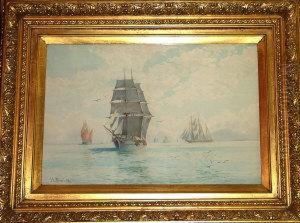J.G. Stuart Paintings
Gilbert Stuart, whose full name is Gilbert Charles Stuart, is a renowned American portraitist known for his depictions of early American leaders and prominent figures. Born on December 3, 1755, in Saunderstown, a village in the colony of Rhode Island and Providence Plantations, he was the third child of Gilbert Stuart, a Scottish immigrant and Elizabeth Anthony Stuart, a member of a prominent colonial American family with English roots.
Stuart displayed artistic talent at an early age and was sent to study under Scottish portraitist Cosmo Alexander, a visitor to the colonies. In 1771, Stuart went to Scotland with Alexander to finish his studies; however, Alexander died in Edinburgh the following year, leaving Stuart without a mentor or means of support. He returned to the colonies in 1773 and launched his career as a portraitist in the years preceding the American Revolution.
Stuart left for England in 1775, partly to escape the turmoil of the American Revolution. There, he became a protégé of American artist Benjamin West, who had established himself at the court of King George III. Stuart's time in West's studio was formative, greatly influencing his style and technique. He achieved great success in London, with his work being exhibited at the Royal Academy, and he painted notable figures such as British nobility and military officers.
Despite his success abroad, Stuart's most enduring legacy is the work he produced after his return to America in 1793. He settled in New York City briefly and then moved to Philadelphia, which was then the seat of the federal government. It was in Philadelphia that Stuart painted his most famous work, the unfinished portrait of George Washington, known as the Athenaeum Portrait, which has been reproduced on the United States one-dollar bill since 1869. Stuart's portraits of Thomas Jefferson, James Madison, James Monroe, and the first six presidents of the United States, among others, have helped to define the visual iconography of the early American republic.
Stuart was not only celebrated for his artistic skill but also for his ability to capture the personality and character of his sitters. He had a keen eye for detail and a distinctive brushwork that combined to create vivid, lifelike portraits. Despite his success and the high demand for his work, Stuart struggled financially throughout his life, due in part to his extravagant lifestyle and poor business acumen.
Gilbert Stuart died on July 9, 1828, in Boston, Massachusetts, leaving behind a legacy as one of America's foremost portraitists. His work continues to be celebrated for its artistic excellence and as a valuable historical record of the figures who shaped the early United States.
